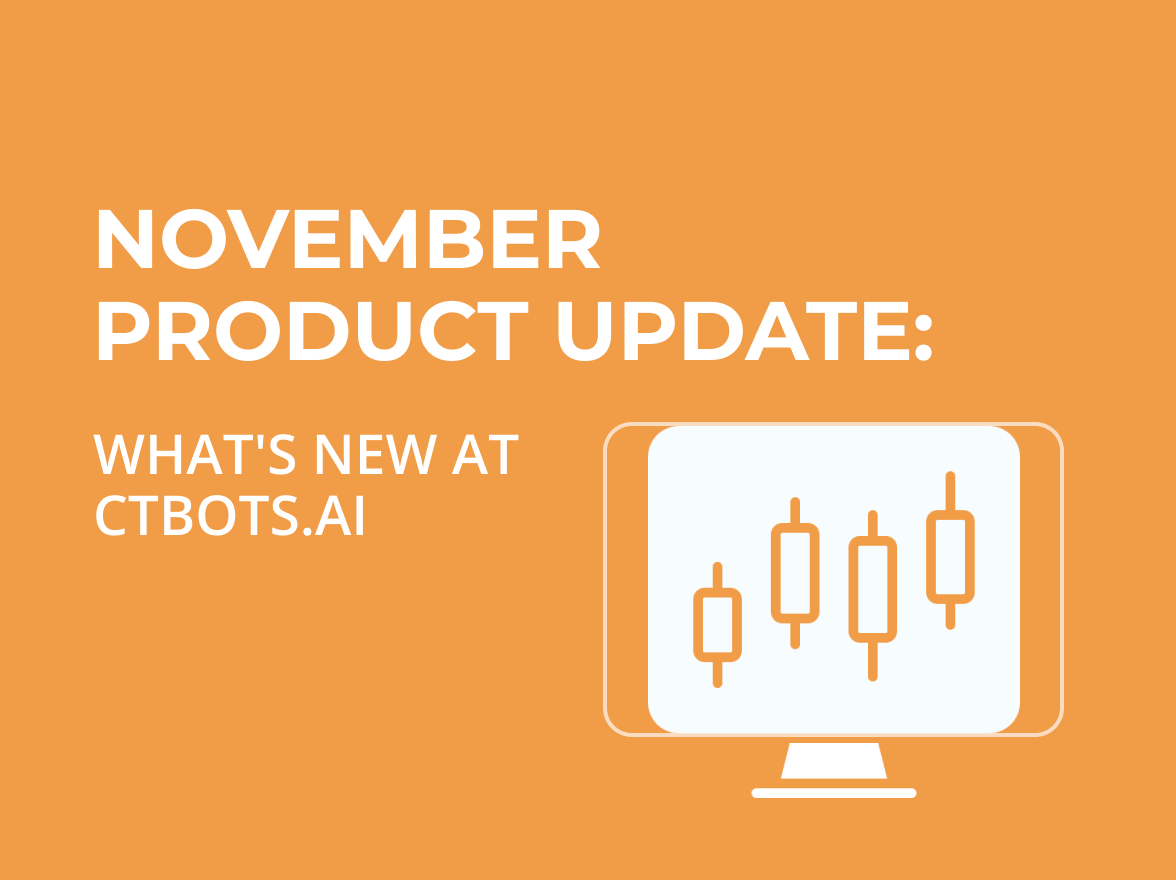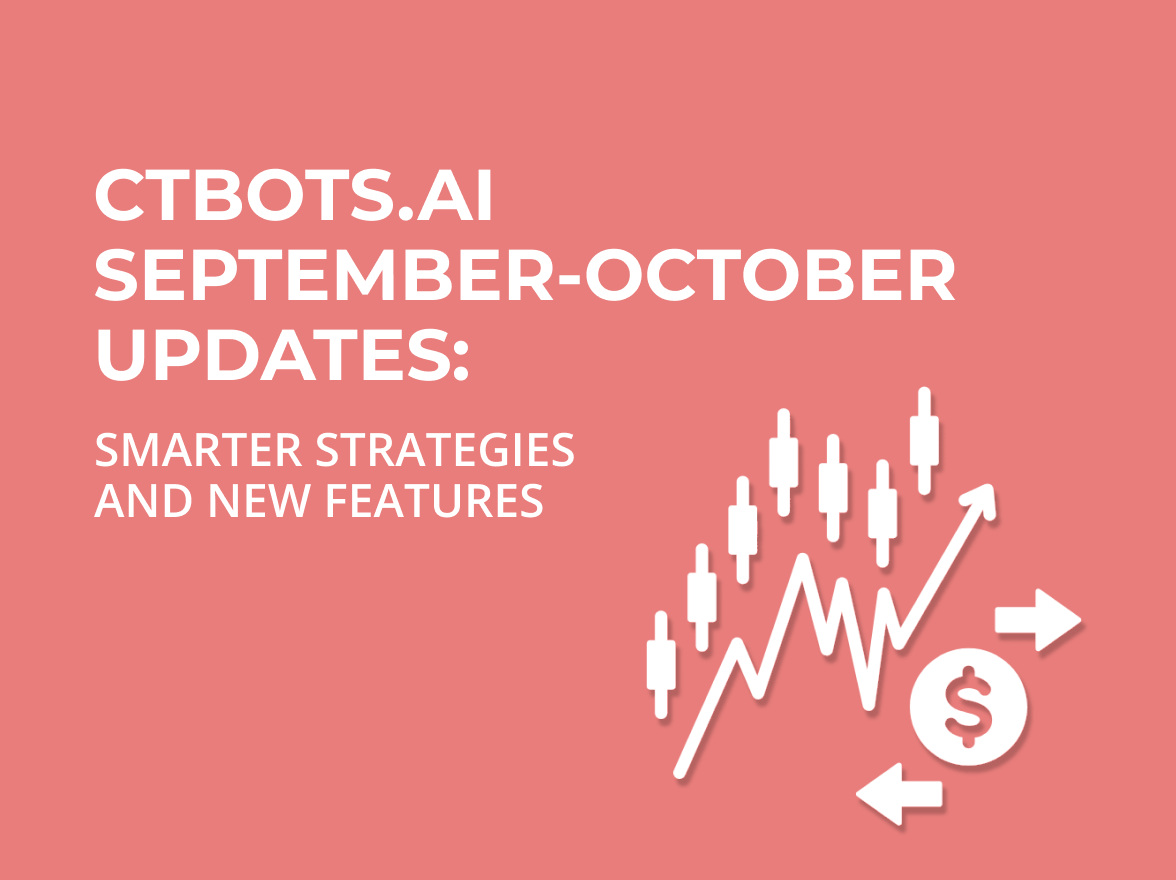November product update: What’s new at ctbots.ai
November was an incredibly productive month for ctbots.ai. We made significant improvements to our strategy logic, portal functionality, and overall bot performance.
Crypto trading is everywhere. From bold advertisements to viral success stories — and maybe even that friend-of-a-friend who “made it” — it’s hard not to feel the pull. The idea of getting started can be exciting… but also intimidating.
If you’re curious about crypto trading but feel overwhelmed by the jargon or unsure where to begin, you’re not alone. Lack of knowledge, fear of failure, and uncertainty are common barriers. The good news? You don’t have to know it all to take your first step — and we’re here to help.
At SSA Group, we understand these challenges. That’s why we created this beginner-friendly guide — not to teach you how to build a complex trading strategy overnight, but to introduce you to the fundamental vocabulary that forms the foundation of crypto trading.
Let’s break it down.

A blockchain is a decentralized digital ledger that records transactions securely and transparently across a network of computers. Each record (called a “block”) contains data and is linked to the one before it, forming a continuous “chain” of information.
It is the core technology that powers cryptocurrencies, ensuring that transactions are verified, time-stamped, and cannot be altered — all without the need for a central authority like a bank or payment provider.
While every cryptocurrency runs on a blockchain, not every blockchain is used just for cryptocurrencies.
Bitcoin blockchain – Designed specifically for processing Bitcoin transactions as a decentralized payment system.
Ethereum – A programmable blockchain that supports not only its native currency (Ether) but also smart contracts, decentralized apps (dApps), and NFTs.
Solana, Polygon, Avalanche – Modern blockchains built for speed, scalability, and low transaction costs — often used in DeFi (decentralized finance) and crypto trading applications.
Tron (TRON) – A blockchain platform optimized for high-throughput and low-cost transactions, particularly in digital content sharing and entertainment industries. Tron supports smart contracts and dApps and is also known for its efficient infrastructure for hosting stablecoins like USDT.
Crypto exchange – A digital platform where users can buy, sell, or trade cryptocurrencies. Think of it as the stock market for crypto.
Cryptocurrency – A digital or virtual currency secured by cryptography. Examples include Bitcoin, Ethereum, Tron and Solana.
Stablecoins – These are cryptocurrencies pegged to a stable asset like the US Dollar or Euro. Their goal is to reduce price volatility — examples include USDT (Tether) and USDC.
Trading pairs – A trading pair shows how one cryptocurrency can be traded for another (e.g., BTC/ETH). It’s like saying, “How much Ethereum do I get for one Bitcoin?”
Base asset – The cryptocurrency you are buying or selling. For example, in BTC/USDT, BTC is the base asset.
Quote asset – The currency you use to price or pay for the base asset. For example, in BTC/USDT, USDT is the quote asset — you’re using USDT to buy or sell BTC.
Volatility – The rate at which an asset’s price changes — crypto is known for high volatility.
Order – A request placed by a trader to buy or sell a cryptocurrency at a specific price.
Matched Order – When a buy and sell order meet and the trade is executed.
Maker order – A maker order is an order that is placed at a price where there is no immediate match — so it stays in the order book, waiting to be filled. It adds to the available liquidity in the market, meaning it becomes part of the list of active buy or sell offers. However, an order is considered a maker only when it is executed by being matched with a future taker order — that’s when it has actually “made” the market.
Taker order – A taker order is placed at a price that matches an existing order, so it is filled immediately. It takes an existing order from the order book. It does not wait — it gets executed on the spot.
Depth of Market (DOM)—also known as the order book—is a real-time view of all buy and sell orders waiting to be executed for a specific asset, such as a cryptocurrency, at various price levels. It shows how much liquidity is available in the market and helps traders assess the supply and demand dynamics.
Profit and Loss (P&L) – The outcome of a trade, showing gains or losses.
Return on Investment (ROI) – The percentage gain or loss on your original investment.
Crypto Trading Strategy – A structured plan for buying/selling based on market signals or trends.
Crypto Trading Bot – Automated software that executes trades based on pre-set strategies.
Account – Your user profile on a crypto exchange, where you can manage funds, place trades, and track activity.
Sub-account – A secondary account under your main profile, useful for separating trading strategies or managing funds for different purposes.
Wallet – A tool for storing cryptocurrencies.
API (Application programming interface) – A way for software applications to communicate with each other. In trading, APIs allow platforms or bots to connect with exchanges to execute trades automatically.
API keys – Secure credentials used to authorize access to your exchange account via an API. They include a public key and a private key, and can be set with specific permissions (e.g., read-only, trading only).
CEX (Centralized exchange) – A crypto exchange run by a company (e.g., Binance, Coinbase). It manages your funds, offers customer support, and sets the rules.
DEX (Decentralized exchange) – A peer-to-peer trading platform with no central authority. Trades happen directly between users via smart contracts (e.g., Uniswap, PancakeSwap).
Spot market – A market where crypto is bought and sold for immediate settlement. You get the asset right away at the current price.
Margin market – A market where you can borrow funds to increase your buying power. This allows for potentially larger profits — and higher risks.
Futures market – A type of trading where you agree to buy or sell crypto at a set price on a future date. Used mostly for speculation or hedging.
Staking – Locking your crypto in a blockchain network to support its operations (like validating transactions). In return, you earn rewards — similar to earning interest.
Building a crypto trading strategy on your own takes time, market knowledge, and a solid investment background. But what if you don’t have all that just yet?
That’s where crypto trading bots come in.
At SSA Group, we’ve developed ctbots.ai — an automated crypto trading platform built for curious beginners and passive income seekers alike.
If you’re exploring alternatives to traditional investments and want a hands-off way to enter the crypto space, this could be a perfect match.
You get the bot. It runs. You monitor its performance. It’s secure, smooth, and easy to use.
🔗 Learn more at https://ctbots.ai/
To help you deepen your understanding of crypto trading, here are recommended learning resources, personally selected by our CEO.
Feel free to explore these resources at your own pace — they’re excellent starting points for becoming a more confident and informed crypto trader.

November was an incredibly productive month for ctbots.ai. We made significant improvements to our strategy logic, portal functionality, and overall bot performance.

Over the past two months, the ctbots.ai team has been working intensively to enhance our trading strategies and platform functionality.
you're currently offline